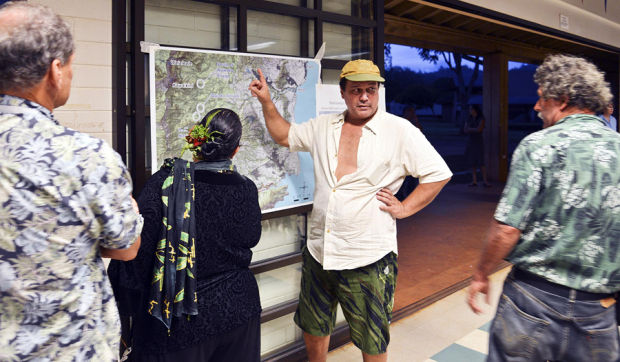LIHUE — The Department of Water will resume its discussion on the Kahili Horizontal Directionally-Drilled Well and Energy Savings Project during a special board meeting Tuesday. The controversial project hit a speed bump in April when Oceanit Laboratories Inc. —
LIHUE — The Department of Water will resume its discussion on the Kahili Horizontal Directionally-Drilled Well and Energy Savings Project during a special board meeting Tuesday.
The controversial project hit a speed bump in April when Oceanit Laboratories Inc. — the consulting firm hired by the DOW to conduct an environmental impact statement — presented false information during a contentious EIS scoping meeting.
A map displayed during the presentation showed five possible locations for the two-mile, high-elevation well, including one that ran to Kawaikini Peak, on the edge of Mount Waialeale’s culturally significant Blue Hole.
The mistake wasn’t realized until a week later. Craddick said the DOW never had plans to drill in that area.
While the intent of the project and the proposed locations have not changed, Craddick said the maps definitely have.
“This is a huge energy savings project,” he said. “(It) reduces our operating cost by 15 percent for hundreds of years, and that’s a benefit to everybody on the island, not just the people in Lihue.”
Tuesday’s meeting will be the first public discussion on the estimated $60 million project since the DOW canceled a series of community meetings in late-May and early-June.
At the time, DOW officials said they would continue evaluating the project before taking further action.
Concerns voiced about the proposal in April included disturbing the island’s central mountains, considered sacred in Hawaiian culture. Others have said the DOW should promote alternative methods to reduce energy costs, reuse of rainwater and installing solar panels to run the water system.
Unlike photovoltaics, the life of a horizontal well is about 200 years, according to Craddick.
“That’s where you get the real benefit over the solar,” he said.
Craddick said it is important that the DOW move forward with the EIS.
“To say we’re not going to go ahead and do an EIS because we might affect the stream flow is kind of shortsighted, because all of the wells, whether in the mountain or down low, affect stream flow,” he said.
The electricity used by DOW for pumping and overall water treatment amounts to roughly $2.5 million annually in the Lihue-Kapaa system.
“We don’t have that cost with that high-level well,” Craddick said. “It’s pure water.”
The DOW has said the project would allow the department to collect the water already being used closer to the source, and that the cost of doing so would be made up in savings over the next 25 years.
For more information visit www.kauaiwater.org or http://kahili.oceanit.com.
• Chris D’Angelo, environmental reporter, can be reached at 245-0441 or cdangelo@thegardenisland.com.


